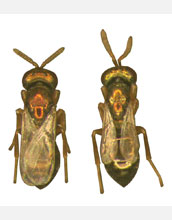
Wing size differences between two Nasonia wasp species are the result of newly discovered genetic differences between the species. The diversity of size and shape differences between other animal species may have similar origins. Credit: David Loehlin, University of Wisconsin, Madison
From spaghetti-like sea anemones to blobby jellyfish to filigreed oak trees, each species in nature is characterized by a unique size and shape. But the evolutionary changes that produce the seemingly limitless diversity of shapes and sizes of organisms on Earth largely remains a mystery. Nevertheless, a better understanding of how cells grow and enable organisms to assume their characteristic sizes and shapes could shed light on diseases that involve cell growth, including cancer and diabetes.
Providing new information about the evolution of the diversity of sizes and shapes in nature is a study identifying genetic differences between two closely related species of Nasonia wasps. These differences give males of one of the Nasonia species small flightless wings and the males of the other Nasonia species flight-worthy wings that are twice as large.
Jack Werren and David Loehlin at the University of Rochester led the research. (Loehlin is now a post-doc at the University of Wisconsin-Madison). Funded by the National Science Foundation (NSF), this week’s issue of Science covers the research.
The research team identified the chromosomal location of the gene responsible for wing size in each of the two Nasonia species, the differences between the DNA sequences of these genes, as well as regulatory controls that determine when, where and how long each species’ growth gene is turned on.
These genetic differences alter both the locations of growth centers in the wings and the timing of growth during Nasonia development–factors that give each species its distinct wing size. As evidence that the identified genes control wing size, the researchers nearly doubled the wing size of the small-winged species by cross-breeding into it the gene from the big-winged species.
Interestingly, Loehlin says the team’s results indicate multiple genetic changes caused the differences in Nasonia wing size-changes, and these changes may have occurred incrementally. “It is possible that the diversity of size and shape differences between other animal species have similar origins in regulator DNA. And the gene we identified is thought to control growth in many other animals, including people.”
The researchers suspect that the small winged Nasonia species evolved from the big-winged species, but it is also possible that the two species evolved in the opposite order.
“Understanding the types of changes in DNA that are responsible for evolution is critical to unraveling the causes of life’s diversity,” says Samuel Scheiner, a program director at NSF. “The recent explosion of new tools for DNA sequencing is now allowing this understanding. This study demonstrates that changes in gene regulation can be important for such evolution.”
The two studied species of Nasonia wasps were chosen for this research because their close genetic relationship coupled with the large difference in their wing sizes makes genetic comparisons between them particularly easy. Nasonia wasps have become a model system for studying evolution because their genetics and breeding system simplify the identification of genetic changes behind complex traits.
Source: National Science Foundation


